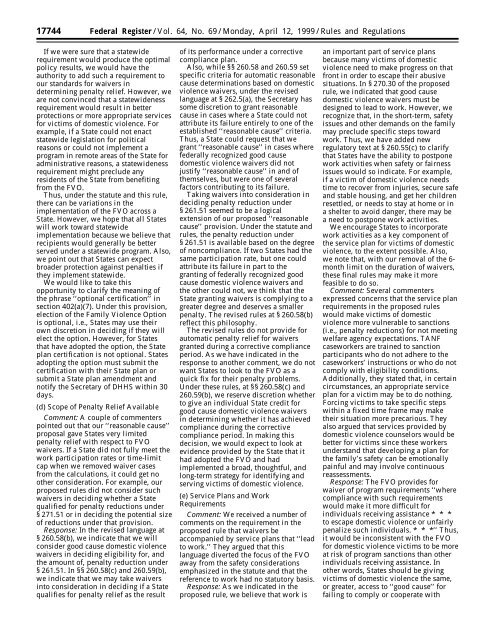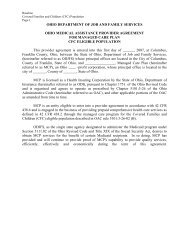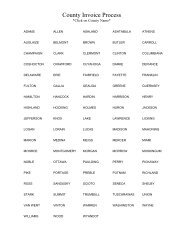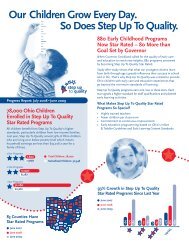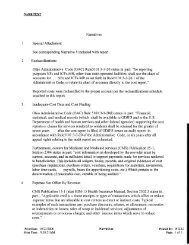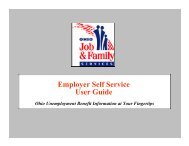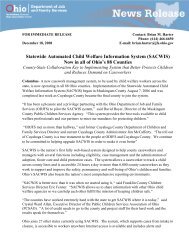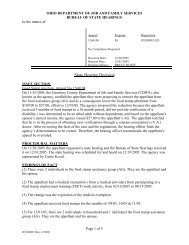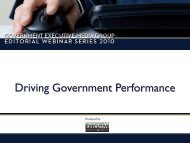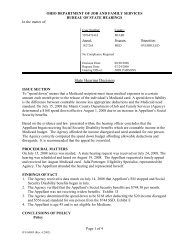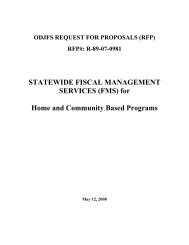Final TANF Rule as published in the Federal Register 4/12/1999
Final TANF Rule as published in the Federal Register 4/12/1999
Final TANF Rule as published in the Federal Register 4/12/1999
Create successful ePaper yourself
Turn your PDF publications into a flip-book with our unique Google optimized e-Paper software.
17744 <strong>Federal</strong> <strong>Register</strong> / Vol. 64, No. 69 / Monday, April <strong>12</strong>, <strong>1999</strong> / <strong>Rule</strong>s and Regulations<br />
If we were sure that a statewide<br />
requirement would produce <strong>the</strong> optimal<br />
policy results, we would have <strong>the</strong><br />
authority to add such a requirement to<br />
our standards for waivers <strong>in</strong><br />
determ<strong>in</strong><strong>in</strong>g penalty relief. However, we<br />
are not conv<strong>in</strong>ced that a statewideness<br />
requirement would result <strong>in</strong> better<br />
protections or more appropriate services<br />
for victims of domestic violence. For<br />
example, if a State could not enact<br />
statewide legislation for political<br />
re<strong>as</strong>ons or could not implement a<br />
program <strong>in</strong> remote are<strong>as</strong> of <strong>the</strong> State for<br />
adm<strong>in</strong>istrative re<strong>as</strong>ons, a statewideness<br />
requirement might preclude any<br />
residents of <strong>the</strong> State from benefit<strong>in</strong>g<br />
from <strong>the</strong> FVO.<br />
Thus, under <strong>the</strong> statute and this rule,<br />
<strong>the</strong>re can be variations <strong>in</strong> <strong>the</strong><br />
implementation of <strong>the</strong> FVO across a<br />
State. However, we hope that all States<br />
will work toward statewide<br />
implementation because we believe that<br />
recipients would generally be better<br />
served under a statewide program. Also,<br />
we po<strong>in</strong>t out that States can expect<br />
broader protection aga<strong>in</strong>st penalties if<br />
<strong>the</strong>y implement statewide.<br />
We would like to take this<br />
opportunity to clarify <strong>the</strong> mean<strong>in</strong>g of<br />
<strong>the</strong> phr<strong>as</strong>e ‘‘optional certification’’ <strong>in</strong><br />
section 402(a)(7). Under this provision,<br />
election of <strong>the</strong> Family Violence Option<br />
is optional, i.e., States may use <strong>the</strong>ir<br />
own discretion <strong>in</strong> decid<strong>in</strong>g if <strong>the</strong>y will<br />
elect <strong>the</strong> option. However, for States<br />
that have adopted <strong>the</strong> option, <strong>the</strong> State<br />
plan certification is not optional. States<br />
adopt<strong>in</strong>g <strong>the</strong> option must submit <strong>the</strong><br />
certification with <strong>the</strong>ir State plan or<br />
submit a State plan amendment and<br />
notify <strong>the</strong> Secretary of DHHS with<strong>in</strong> 30<br />
days.<br />
(d) Scope of Penalty Relief Available<br />
Comment: A couple of commenters<br />
po<strong>in</strong>ted out that our ‘‘re<strong>as</strong>onable cause’’<br />
proposal gave States very limited<br />
penalty relief with respect to FVO<br />
waivers. If a State did not fully meet <strong>the</strong><br />
work participation rates or time-limit<br />
cap when we removed waiver c<strong>as</strong>es<br />
from <strong>the</strong> calculations, it could get no<br />
o<strong>the</strong>r consideration. For example, our<br />
proposed rules did not consider such<br />
waivers <strong>in</strong> decid<strong>in</strong>g whe<strong>the</strong>r a State<br />
qualified for penalty reductions under<br />
§ 271.51 or <strong>in</strong> decid<strong>in</strong>g <strong>the</strong> potential size<br />
of reductions under that provision.<br />
Response: In <strong>the</strong> revised language at<br />
§ 260.58(b), we <strong>in</strong>dicate that we will<br />
consider good cause domestic violence<br />
waivers <strong>in</strong> decid<strong>in</strong>g eligibility for, and<br />
<strong>the</strong> amount of, penalty reduction under<br />
§ 261.51. In §§ 260.58(c) and 260.59(b),<br />
we <strong>in</strong>dicate that we may take waivers<br />
<strong>in</strong>to consideration <strong>in</strong> decid<strong>in</strong>g if a State<br />
qualifies for penalty relief <strong>as</strong> <strong>the</strong> result<br />
of its performance under a corrective<br />
compliance plan.<br />
Also, while §§ 260.58 and 260.59 set<br />
specific criteria for automatic re<strong>as</strong>onable<br />
cause determ<strong>in</strong>ations b<strong>as</strong>ed on domestic<br />
violence waivers, under <strong>the</strong> revised<br />
language at § 262.5(a), <strong>the</strong> Secretary h<strong>as</strong><br />
some discretion to grant re<strong>as</strong>onable<br />
cause <strong>in</strong> c<strong>as</strong>es where a State could not<br />
attribute its failure entirely to one of <strong>the</strong><br />
established ‘‘re<strong>as</strong>onable cause’’ criteria.<br />
Thus, a State could request that we<br />
grant ‘‘re<strong>as</strong>onable cause’’ <strong>in</strong> c<strong>as</strong>es where<br />
federally recognized good cause<br />
domestic violence waivers did not<br />
justify ‘‘re<strong>as</strong>onable cause’’ <strong>in</strong> and of<br />
<strong>the</strong>mselves, but were one of several<br />
factors contribut<strong>in</strong>g to its failure.<br />
Tak<strong>in</strong>g waivers <strong>in</strong>to consideration <strong>in</strong><br />
decid<strong>in</strong>g penalty reduction under<br />
§ 261.51 seemed to be a logical<br />
extension of our proposed ‘‘re<strong>as</strong>onable<br />
cause’’ provision. Under <strong>the</strong> statute and<br />
rules, <strong>the</strong> penalty reduction under<br />
§ 261.51 is available b<strong>as</strong>ed on <strong>the</strong> degree<br />
of noncompliance. If two States had <strong>the</strong><br />
same participation rate, but one could<br />
attribute its failure <strong>in</strong> part to <strong>the</strong><br />
grant<strong>in</strong>g of federally recognized good<br />
cause domestic violence waivers and<br />
<strong>the</strong> o<strong>the</strong>r could not, we th<strong>in</strong>k that <strong>the</strong><br />
State grant<strong>in</strong>g waivers is comply<strong>in</strong>g to a<br />
greater degree and deserves a smaller<br />
penalty. The revised rules at § 260.58(b)<br />
reflect this philosophy.<br />
The revised rules do not provide for<br />
automatic penalty relief for waivers<br />
granted dur<strong>in</strong>g a corrective compliance<br />
period. As we have <strong>in</strong>dicated <strong>in</strong> <strong>the</strong><br />
response to ano<strong>the</strong>r comment, we do not<br />
want States to look to <strong>the</strong> FVO <strong>as</strong> a<br />
quick fix for <strong>the</strong>ir penalty problems.<br />
Under <strong>the</strong>se rules, at §§ 260.58(c) and<br />
260.59(b), we reserve discretion whe<strong>the</strong>r<br />
to give an <strong>in</strong>dividual State credit for<br />
good cause domestic violence waivers<br />
<strong>in</strong> determ<strong>in</strong><strong>in</strong>g whe<strong>the</strong>r it h<strong>as</strong> achieved<br />
compliance dur<strong>in</strong>g <strong>the</strong> corrective<br />
compliance period. In mak<strong>in</strong>g this<br />
decision, we would expect to look at<br />
evidence provided by <strong>the</strong> State that it<br />
had adopted <strong>the</strong> FVO and had<br />
implemented a broad, thoughtful, and<br />
long-term strategy for identify<strong>in</strong>g and<br />
serv<strong>in</strong>g victims of domestic violence.<br />
(e) Service Plans and Work<br />
Requirements<br />
Comment: We received a number of<br />
comments on <strong>the</strong> requirement <strong>in</strong> <strong>the</strong><br />
proposed rule that waivers be<br />
accompanied by service plans that ‘‘lead<br />
to work.’’ They argued that this<br />
language diverted <strong>the</strong> focus of <strong>the</strong> FVO<br />
away from <strong>the</strong> safety considerations<br />
emph<strong>as</strong>ized <strong>in</strong> <strong>the</strong> statute and that <strong>the</strong><br />
reference to work had no statutory b<strong>as</strong>is.<br />
Response: As we <strong>in</strong>dicated <strong>in</strong> <strong>the</strong><br />
proposed rule, we believe that work is<br />
an important part of service plans<br />
because many victims of domestic<br />
violence need to make progress on that<br />
front <strong>in</strong> order to escape <strong>the</strong>ir abusive<br />
situations. In § 270.30 of <strong>the</strong> proposed<br />
rule, we <strong>in</strong>dicated that good cause<br />
domestic violence waivers must be<br />
designed to lead to work. However, we<br />
recognize that, <strong>in</strong> <strong>the</strong> short-term, safety<br />
issues and o<strong>the</strong>r demands on <strong>the</strong> family<br />
may preclude specific steps toward<br />
work. Thus, we have added new<br />
regulatory text at § 260.55(c) to clarify<br />
that States have <strong>the</strong> ability to postpone<br />
work activities when safety or fairness<br />
issues would so <strong>in</strong>dicate. For example,<br />
if a victim of domestic violence needs<br />
time to recover from <strong>in</strong>juries, secure safe<br />
and stable hous<strong>in</strong>g, and get her children<br />
resettled, or needs to stay at home or <strong>in</strong><br />
a shelter to avoid danger, <strong>the</strong>re may be<br />
a need to postpone work activities.<br />
We encourage States to <strong>in</strong>corporate<br />
work activities <strong>as</strong> a key component of<br />
<strong>the</strong> service plan for victims of domestic<br />
violence, to <strong>the</strong> extent possible. Also,<br />
we note that, with our removal of <strong>the</strong> 6month<br />
limit on <strong>the</strong> duration of waivers,<br />
<strong>the</strong>se f<strong>in</strong>al rules may make it more<br />
fe<strong>as</strong>ible to do so.<br />
Comment: Several commenters<br />
expressed concerns that <strong>the</strong> service plan<br />
requirements <strong>in</strong> <strong>the</strong> proposed rules<br />
would make victims of domestic<br />
violence more vulnerable to sanctions<br />
(i.e., penalty reductions) for not meet<strong>in</strong>g<br />
welfare agency expectations. <strong>TANF</strong><br />
c<strong>as</strong>eworkers are tra<strong>in</strong>ed to sanction<br />
participants who do not adhere to <strong>the</strong><br />
c<strong>as</strong>eworkers’ <strong>in</strong>structions or who do not<br />
comply with eligibility conditions.<br />
Additionally, <strong>the</strong>y stated that, <strong>in</strong> certa<strong>in</strong><br />
circumstances, an appropriate service<br />
plan for a victim may be to do noth<strong>in</strong>g.<br />
Forc<strong>in</strong>g victims to take specific steps<br />
with<strong>in</strong> a fixed time frame may make<br />
<strong>the</strong>ir situation more precarious. They<br />
also argued that services provided by<br />
domestic violence counselors would be<br />
better for victims s<strong>in</strong>ce <strong>the</strong>se workers<br />
understand that develop<strong>in</strong>g a plan for<br />
<strong>the</strong> family’s safety can be emotionally<br />
pa<strong>in</strong>ful and may <strong>in</strong>volve cont<strong>in</strong>uous<br />
re<strong>as</strong>sessments.<br />
Response: The FVO provides for<br />
waiver of program requirements ‘‘where<br />
compliance with such requirements<br />
would make it more difficult for<br />
<strong>in</strong>dividuals receiv<strong>in</strong>g <strong>as</strong>sistance * * *<br />
to escape domestic violence or unfairly<br />
penalize such <strong>in</strong>dividuals. * * *’’ Thus,<br />
it would be <strong>in</strong>consistent with <strong>the</strong> FVO<br />
for domestic violence victims to be more<br />
at risk of program sanctions than o<strong>the</strong>r<br />
<strong>in</strong>dividuals receiv<strong>in</strong>g <strong>as</strong>sistance. In<br />
o<strong>the</strong>r words, States should be giv<strong>in</strong>g<br />
victims of domestic violence <strong>the</strong> same,<br />
or greater, access to ‘‘good cause’’ for<br />
fail<strong>in</strong>g to comply or cooperate with


